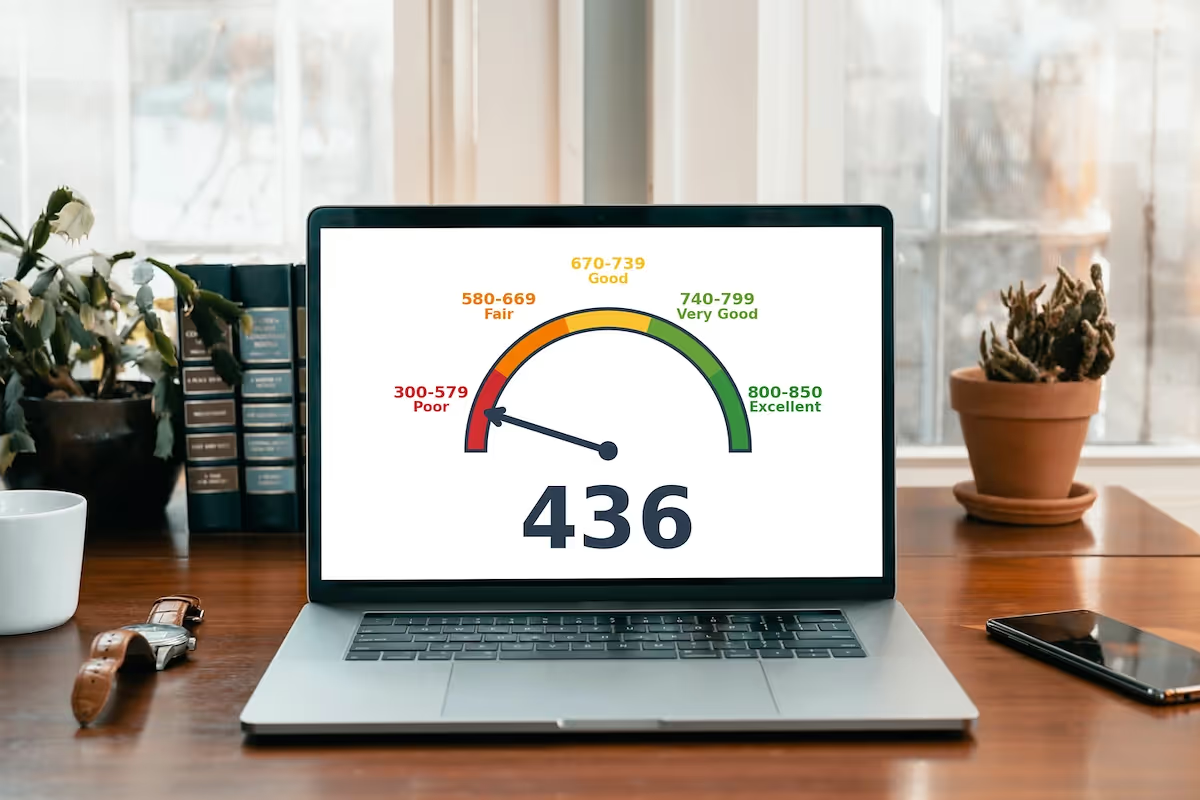
Kudos has partnered with CardRatings and Red Ventures for our coverage of credit card products. Kudos, CardRatings, and Red Ventures may receive a commission from card issuers. Kudos may receive commission from card issuers. Some of the card offers that appear on Kudos are from advertisers and may impact how and where card products appear on the site. Kudos tries to include as many card companies and offers as we are aware of, including offers from issuers that don't pay us, but we may not cover all card companies or all available card offers. You don't have to use our links, but we're grateful when you do!
436 Credit score: What You Need to Know in 2025
July 1, 2025


TL;DR
A 436 credit score is a starting point with considerable room for growth, offering a clear path toward building a stronger financial future. This score falls into the Poor FICO credit score range, which means taking strategic steps now can lead to substantial improvements.
What Does a 436 Credit Score Mean?
A credit score of 436 is considered “poor” on the FICO scoring model, which ranges from 300 to 850. This score places you in the highest-risk category for lenders, indicating a history of significant financial challenges. Consequently, you can expect this number to have a substantial impact on your ability to access financial products and services, as it suggests a high likelihood of future delinquency.
With a 436 credit score, you will likely face immediate rejections for most mainstream loans and credit cards. If you are approved for any credit, it will almost certainly come with very high interest rates and restrictive terms. This can also affect other areas of your life, such as renting an apartment or signing up for utility services. While the road ahead is challenging, understanding your current standing is the first step toward rebuilding.
Who Has a 436 Credit Score?
While age isn't a direct factor in credit score calculations, there are clear trends showing that scores tend to improve over time. According to 2023 Experian data, the average FICO score varies significantly across different generations. Here’s a breakdown:
- Generation Z (ages 18-26): 680
- Millennials (ages 27-42): 690
- Generation X (ages 43-58): 709
- Baby Boomers (ages 59-77): 745
- Silent Generation (ages 78+): 760
Credit Cards With a 436 Credit Score
A credit score of 436 is considered very poor, which will significantly impact your ability to get approved for a credit card. Lenders generally see this score as high-risk, meaning most applications for traditional unsecured cards will likely be denied. Your options will probably be limited to secured credit cards or other products specifically designed for individuals rebuilding their credit.
Kudos uses AI-powered tools to personalize credit card recommendations based on your unique financial situation and goals. These tools provide insights on how different cards may impact your credit score, helping you find the best options for your circumstances.
Auto Loans and a 436 Credit Score
A 436 credit score places you in the deep subprime category, which can make securing an auto loan challenging. While approval is still possible, you can expect to face significantly higher interest rates and less favorable loan terms.
According to 2025 market data, here is how average auto loan rates break down by credit score:
- Super-prime (781-850): 5.25% for new cars and 7.13% for used cars
- Prime (661-780): 6.87% for new cars and 9.36% for used cars
- Non-prime (601-660): 9.83% for new cars and 13.92% for used cars
- Subprime (501-600): 13.18% for new cars and 18.86% for used cars
- Deep subprime (300-500): 15.77% for new cars and 21.55% for used cars
Mortgages at a 436 Credit Score
Securing a mortgage with a 436 credit score is highly unlikely through mainstream lenders. According to current mortgage requirements, even government-backed FHA loans—the most accessible option for low-credit borrowers—require a minimum score of 500 with a 10% down payment. Your options will be extremely limited, and you will likely need to improve your credit before qualifying for a home loan.
If you were to find a specialty lender, a low score results in unfavorable terms. You can expect significantly higher interest rates, which can add tens of thousands to the loan’s lifetime cost. Lenders will also demand a larger down payment, charge higher fees, and may cap the total amount you can borrow, limiting your home choices.
What's in a Credit Score?
Figuring out what goes into your credit score can feel like trying to solve a complex puzzle, but it generally boils down to a handful of key elements. The most common factors include:
- Your payment history, which tracks whether you pay your bills on time, is the most significant factor.
- Credit utilization, or the amount of credit you're using compared to your total available credit, also plays a major role.
- The length of your credit history demonstrates your experience with managing credit over time.
- Having a healthy mix of different types of credit, such as credit cards and installment loans, can positively impact your score.
- Finally, recent credit inquiries, which occur when you apply for new credit, are also taken into account.
How to Improve Your 436 Credit Score
Improving your credit score is not only possible but can lead to better financial opportunities, and there are proven methods to do so. With consistent positive behavior, most people can see meaningful changes to their credit profile within three to six months.
- Monitor your credit reports regularly. This allows you to identify and dispute any inaccuracies or fraudulent accounts that could be dragging your score down. For a score in the poor range, correcting errors can be one of the fastest ways to see an improvement.
- Establish automatic bill payments. Your payment history is the single most significant factor in your credit score, so ensuring every bill is paid on time is critical. This action builds a positive track record and demonstrates reliability to lenders over time.
- Apply for a secured credit card. These cards are designed for individuals with damaged or limited credit and require a cash deposit that acts as your credit limit. Making small, regular purchases and paying the bill on time helps establish a positive payment history.
- Reduce your credit utilization ratio. This ratio compares your credit card balances to your total credit limits, and a high ratio can significantly lower your score. Focus on paying down existing balances to below 30% to show lenders you can manage credit responsibly.
The Kudos platform can help you manage your cards and monitor your score as you work to improve your credit health.
Unlock your extra benefits when you become a Kudos member

Turn your online shopping into even more rewards

Join over 400,000 members simplifying their finances

Editorial Disclosure: Opinions expressed here are those of Kudos alone, not those of any bank, credit card issuer, hotel, airline, or other entity. This content has not been reviewed, approved or otherwise endorsed by any of the entities included within the post.



































.webp)

.webp)




.webp)

